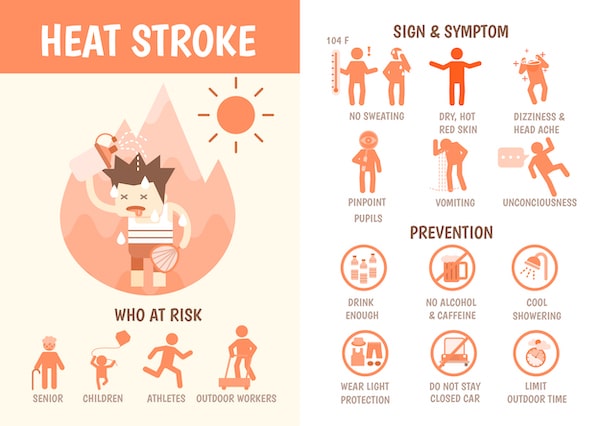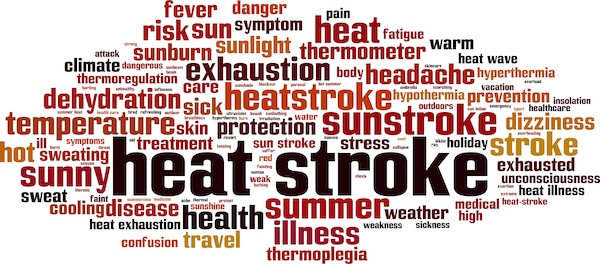What are the Signs of Heat Exhaustion? – [Updated for 2023]

Heat exhaustion — what is it, how does it affect us, and what are the signs to look for?
There are various degrees of exertional heat exhaustion that can lead to serious conditions. An individual experiencing heat exhaustion and heat stroke could experience serious injury or even fatal consequences.
How can you tell when someone is suffering from heat exhaustion? What are the signs of heat exhaustion?
This guide will answer these questions and more.
Heat Stress Factors
It’s important to take extra precautions and understand the many risk factors involved with heat exhaustion. You must understand your body’s ability to withstand heat exhaustion and heatstroke. A great place to start is by learning the warning signs of heat exhaustion along with preventative measures that can be taken. Also, key to all of this information is giving your employees heat stress training which will keep them educated and safe on the job.

Factors of Heat Related Illness Include the Following:
High Temperatures
Temperatures 86 to 96 degrees can represent levels of extreme heat and a high heat index. Hot weather can create an environment that escalates these conditions, especially during heat waves. In any event, you can keep track of the heat index using a weather application.
Humidity
Humidity refers to the amount of moisture in the air. High humidity in the atmosphere can intensify extreme temperatures. This can affect the rate at which your sweat evaporates and reduces the body’s ability to cool down. Therefore, humid weather can add an increased risk for illness.
There are a wide variety of risk factors involved with hot weather. It’s important to note quick temperature changes and weather patterns. If symptoms worsen, take the individual into an air-conditioned building.
Workload Intensity
The mixture of weather conditions and strenuous physical activity can create an intense environment. Think about the type of activity an employee, athlete, or individual is doing outside. How long are they doing this activity? How strenuous is the activity? All of this factors into heat exhaustion.
Athletic Heat Injury
Athletes and outdoor workers are more prone to heat illness. To help protect against harsh weather conditions, they need to wear breathable, lightweight clothing. Cotton is great since it absorbs sweat and offers good ventilation. This allows the body heat to escape, making athletes or outdoor employees feel cooler.
Personal Medical History
Be cautious of a person’s medical history in regards to hot weather. Prior medical conditions can lead to other heat-related illnesses. Speak with your doctor if you’re concerned your medical history may affect your probability of heat exhaustion.
Age
Age is another important factor to consider when dealing with hot weather. People 65 years or older are more prone to developing heat-related health concerns since their bodies can’t adjust to sudden temperature changes as quickly as younger people.
High Blood Pressure
Metabolism and blood pressure are other factors that may contribute to heat exhaustion. The rate at which a person burns calories can add to health conditions. Patients may need to treat high blood pressure before ensuring their safety in high temperatures.
Drugs & Alcohol
Individuals drinking alcohol or using drugs are more susceptible to heat illness. This is because body temperatures begin to rise much faster than if you were sober. Alcohol also dehydrates the body causing individuals to perspire more than normal.
Radiant Surfaces
Don’t just check the presence of the hot sun. Be aware of radiant or conductive sources in the area. For instance, if you are working with cooks, they may be near hot sources that can trigger exhaustion. Hot objects can add to the environment, causing excessive sweating.
Body Temperature
All of these factors will cause the body’s core temperature to rise leading to serious complications when left untreated. It’s important to find ways to prevent body temperature and heat index from rising when outdoors. We’ll go over preventative measures you can take a little later.

5 Types of Heat-Related Illness
Exposure to extreme temperatures can lead to heat-related illness. Here are 5 types to look out for:
Heat Stroke
Heat stroke is a condition that can lead to serious injury or even death. It’s the most serious on this list of heat-related illnesses and strikes when body temperature can’t be controlled. It goes without saying but if you or someone is experiencing a heat stroke, immediate medical attention needs to be called.
With heat stroke, the internal temperature rises to a critical rate over 105 degrees. Heat exhaustion symptoms to look for that could lead to heat stroke include:
- Confusion or irrationality
- Loss of consciousness
- Physical convulsions or contortions
- Red and dry skin that is radiant
- Lack of sweating
- A rapid pulse
These are all symptoms of exhaustion from hot temperatures and require immediate medical attention.
Heat Exhaustion
Heat exhaustion is a similar condition with serious implications. It is also considered to be a serious medical condition requiring immediate attention for those who develop heat exhaustion. For individuals who suffer from, symptoms of heat exhaustion include:
- Headache and Nausea
- A sense of vertigo or fainting
- Heavy Sweating
- Pale, moist, cool skin
- Severe Thirst
Collapse
Collapse occurs when the brain doesn’t receive enough oxygen. This is due to the blood pools in the extremities, taking blood away from other vital organs and causing loss of consciousness.
When a person doesn’t drink fluids, especially during physical activity, dehydration can lead to collapse. Other causes may include standing with knees locked for long periods in the sun or when it’s a high temperature inside. Symptoms include:
- Dizziness and confusion
- Fainting or sudden collapse
- Redness in the face
Heat Cramps
Heat cramps are the mildest form of heat illness and happen when there’s too much or too little salt within the body. They come from painful muscle cramping, often after intense sweating in high heat.
Typically, these muscle cramps occur after hard labor. For example, if you’re working in construction, you may experience this muscle cramp after intensive labor onsite.
Drinking fluids can help you adjust. After every 15 to 20 minutes, you’ll want to replace the water the body loses from heavy sweating. Symptoms of these muscle cramps include:
- Muscle spasms
- Abdominal pain
- General nausea and aching
Heat Rash
This type of rash is the prickly sensation typically caused by unevaporated sweat on the skin. They appear as small red dots on the skin. This usually occurs in areas where the clothing is restricted, and it’s best to opt for loose-fitting clothing.
This illness can be dangerous, especially since it can become infected. Humidity plays a big role in these cases. In humid weather, the sweat cannot leave the skin, thus causing an infection. Some symptoms include:
- Prickling sensation
- Red small spots
- Heavy sweating
- Fatigue
General Heat Illness or Fatigue
Heat fatigue can be described as a mental strain that provides temporary discomfort. You’ll see a noticeable decline in task performance, alertness, and coordination.
Fluid loss is a significant cause of heat illness. But, sports drinks can help relieve the symptoms of these illnesses.
Generally, this is more of a delayed reaction. They are not instantaneous, like burns or collapses, but may take hours or even days to develop. Symptoms include:
- Dark Yellow Urine
- Dizziness and Confusion
- Lack of coordination
Preventing Heat Exhaustion
Whether or not there is any medical emergency staff on staff, employees should be well versed in identifying the signs of heat-related illnesses. They should also know basic prevention and treatment methods for emergencies. Familiarizing yourself with the warning signs and symptoms of heat exhaustion is essential.
While not every employee needs to be ready to treat as a nurse or doctor would, some basic medical education could be crucial in life-threatening situations where these illnesses are more likely.
Tips for Prevention
Want to know how to get started with preventing heat stress related problems for your team? Here are some basic tips every workplace should enforce to avoid life-threatening situations:
- Water Access – Hydration is the name of the game. I always keep cold water around so anyone can ensure they drink plenty of water.
- Find Shade – See if you can find a cool place away from direct sunlight. An indoor area with air conditioning can help provide relief. Break areas should be no further than 40-50 yards away. Ensure it’s not in an enclosed space like a parked car.
- Monitoring Hot Weather – Know the impending weather conditions, and check for hot weather. This way, you can plan schedules accordingly.
- Sports drink – Many beverages utilize electrolytes and magnesium to help combat exhaustion and muscle cramping. This is even more powerful than water and should be kept where it’s easily accessible and in a cool place.
- Cool shower – Dunking an individual into the cool water with several ice packs can help alleviate the symptoms of exhaustion.
Stay Safe — Stop Heat-Related Syndromes
There must be precautions to prevent heat exhaustion in workplaces where employees are exposed to extreme temperatures.
There are several ways to return someone to a normal body temperature, such as prioritizing hydration and avoiding the times of the day with the hottest temperatures. This way, you keep heat loss consistent and prevent illness for your team.